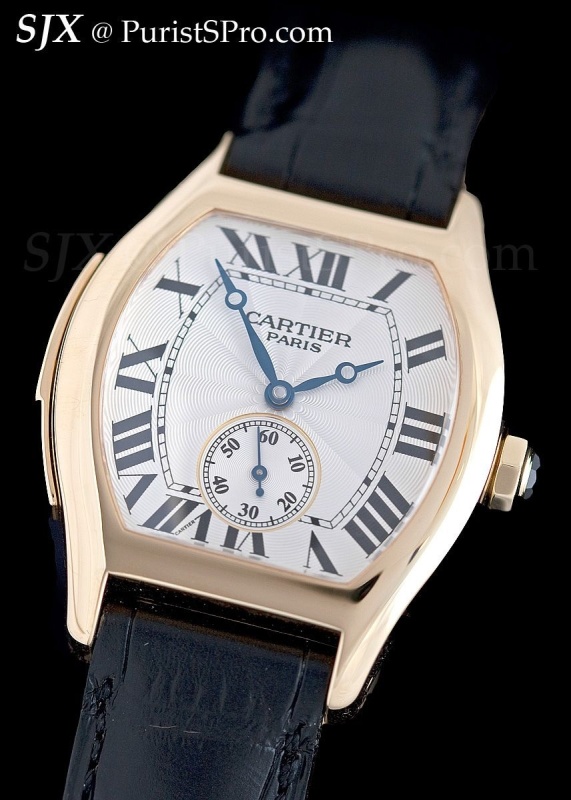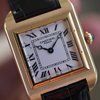
SJX
[Purist]
8540

An in-depth explanation of the Cartier Minute Repeater with Flying Tourbillon
From the highly desirable 1920s pieces with EWC calibres to the Collection Privee Cartier Paris (CPCP) of the late nineties, Cartier has had significant accomplishments in high horology over the last century.


The CPCP Tortue repeater
The top of the line CPCP line at one point was the Tortue minute repeater, a beefed up modern interpretation of the Tortue repeater from the 1920s. Though quite beautiful, the CPCP repeater used a Renaud & Papi calibre that was somewhat lacklustre in sound, it was soft with significant regulator noise, not unlike many repeater movements of nineties.


The 1920s Tortue repeater with a modern Santos 100
But the CPCP line was discontinued when Cartier made its most serious foray in recent years into high end watchmaking with the Fine Watchmaking range in 2008. Since then Cartier has unveiled 15 calibres, with the most complex being the Rotonde de Cartier Minute Repeater Flying Tourbillon just launched at SIHH in January. This is Cartier’s second modern attempt at a minute repeater, it is an in-house development, and this time Cartier has got it right.
Unlike some of the other Cartier Fine Watchmaking timepieces that have taken a creative approach to a complication, the minute repeater is traditional in its conception and execution. Perhaps the most unusual aspect of the movement is the fact that it has been inverted with the gongs and hammers exposed on the dial for aesthetic purposes.


Instead of creativity, emphasis was placed on the sound, as well as construction and finishing. According to Carole Forestier, the head of technical development at the Cartier manufacture, the 9402 MC movement was “designed around the sound [of the repeater]”.
Four criteria – loudness, pitch, timbre and reverberation – are essential for high quality sound, according to Ms Forestier. So the goal during movement development was to achieve top performance in each of these categories.
Loudness, which is measured in decibels (dB), is easy to grasp. Any sound over 10 dB is audible to humans but anything beyond 90 dB is unhealthy. The goal for the repeater movement was to be clearly audible, meaning the wearer doesn’t have to bring the watch to his ear to hear the repeater.
Cartier achieved a solid 68 dB with the titanium case repeater and 63 dB for the rose gold version, putting on par with the minute repeaters from Jaeger-LeCoultre, which are widely regarded as the loudest available.
To optimise loudness, the watch was designed to have a low case mass to vibrating mass (the hammers and gongs) ratio. That is why the case has a button, instead of the traditional slide, which is heavier since has a larger volume of metal.

For the same reason, the repeater in the titanium case is louder than in the rose gold case since titanium is less dense. And speed of sound waves through a material is inverse to its density which means the sound of the repeater travels better in titanium (and that’s also why gold repeaters generally sound better than platinum).
Because titanium is light, and the case is fairly thin – most of the volume is occupied by the 39.7 mm wide calibre – the repeater in titanium weighs a mere 32.1 g sans strap, which is remarkably for a 45 mm watch.
Another important consideration for loudness was the movement attachment. In regular watches movements are mounted with screws at two points, but here the calibre is mounted at four points. The increased number of contact points with the case maximises the transmissions of vibrations through the case.
In addition to the case, the square cross sections of the gongs were also designed to optimise loudness. A traditional gong with a round profile has only a single, small point of contact with the hammer.
In contrast, the flat head of the hammer has a much larger contact area with a square gong since both surfaces are parallel, which increases the speed at which the vibrations travel through the gong, thus increasing loudness. It should be noted, however, that Cartier is not the first watchmaker to use such gongs; it was JLC with the Master Minute Repeater.

But loudness of course, is not all, as those who are familiar with the beautiful tones of Patek Philippe’s repeaters will attest. Pitch, which refers to the highness of a note, is a key component of a pleasant sound.
Consequently, the two strikes of the repeater have to be of the right pitch in order to sound right, neither too high nor too low. But not only do they have to be the right pitch, but they must have the right tonality – harmonious in relation to each other. Tonality is especially important when the quarters are being struck with two notes.
B in the fifth octave and D in the sixth octave were chosen as the best sounding pair of high and low notes. This selection was done by a company based in the south of France that specialises in acoustics for the car industry. In the words of Ms Forestier, they are the ones who make sure the car door slams with the right sound.
But the harmony of the two notes is also affected by other sounds, like that of the regulator, which is the bane of many repeaters, especially those designed in the nineties and earlier. This was a problem with the CPCP Tortue repeater.
So a silent governor was used, visible at six o’clock on the dial. Silent governors gradually becoming more widespread for new repeater calibres; since the early 2000s they have been used in many new minute repeating calibres.
In addition to pitch, timbre is third element in a good repeater sound. Technically it refers to harmonics of the note, which is derived from the fundamental and dominant frequencies working together. What that means is that two instruments, a trumpet and violin, for instance, can play the same note with the same pitch and same volume, but sound clearly different. That is timbre, put simply.
In the case of the repeater, instead of a trumpet or violin, the sound comes from the gong. Hence many iterations of the gong were experimented with, varying the shape, length and cross section, until the ideal timbre was achieved.
One of the primary factors affecting timbre was hardness of the hardened steel used for the gong, as the harder the material, the increase in the harmonics of the note. Cartier used a steel alloy of a secret formula for the gong; Ms Forestier notes that the hardened steel balance staff is 600 Vickers while the alloy of the gong is even harder.
The last component is reverberation, or how long the note lingers. A gently lingering note is more pleasant than one which ends sharply. To maximise the reverberation, the hammer strikes on the gong have to be of constant power, to ensure acoustic resonance. And the interval between strikes has to be of the right duration, and every interval has to be the same length.
All of these factors meant that the process of developing the repeater was scientific and also lengthy. But the prototype of the repeater sounds excellent, so clearly the in-depth acoustic research has paid off. The final production pieces, which will come sometime at the end of the year, will certainly be outstanding.
Visually the repeater is handsome, with a strikingly symmetrical, two-level dial with in the style of Cartier Fine Watchmaking. All the traditional Cartier design elements are present too, blue steel sword hands, guilloche and Roman numerals. However, the 45 mm case is large and may be discouraging for some.
Given how complex a minute repeater alone is, the tourbillon at 12 o’clock seems superfluous, and it does clutter the dial somewhat. I would have preferred the watch sans tourbillon. But a tourbillon is not overly difficult to include and still carries cachet, especially amongst novice collectors, so its inclusion is understandable from a commercial perspective.
And the reverse of the watch is a delight. The large calibre fills up the case nicely – no wide movement ring here – and shows off the exceptional level of finishing. The movement has the Geneva Seal. But seal or not, it is appreciably the best finished movement Cartier makes today, on par with the finishing from top tier haute horlogerie brands. Carole said extra effort was made to ensure the finishing of this movement was truly haute de gamme, not just because it’s the flagship product but also because the quality and finishing need to correspond with the price.



Cartier has made tremendous progress in high horology since 2008 and the minute repeater is the strongest proof of this yet.
This message has been edited by SJX on 2012-08-12 02:28:21 This message has been edited by SJX on 2012-09-03 07:55:17 This message has been edited by SJX on 2012-09-03 08:15:07

An in-depth explanation of the Cartier Minute Repeater with Flying Tourbillon


Thanks a lot for this comprehensive post SJX.

Delivery starts next year

Great post SJX

Is this the same watch that KIH reported on

Yes it is the same prototype
